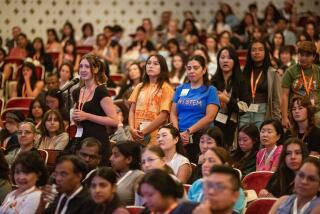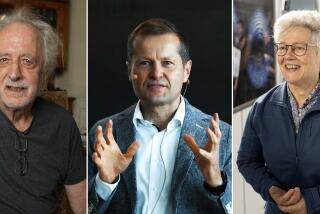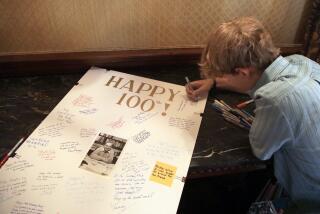A Bright Light : USC Scientist Makes an Art of Work With Lasers
The artistic potential of lasers nearly seduced Elsa Garmire away from science in the late 1960s and early 1970s.
She was one of the founders of the firm that eventually created the Laserium light show at the Griffith Observatory, and she helped make a well-known experimental mirror and light display for the 1970 World’s Fair in Japan. One of her laser photographs even became the pattern for an avant-garde dress material.
“It’s beautiful, incredibly beautiful,” Garmire said of the intense, single-color light beam created by laser machines. “It has that sparkling look, and that’s magic.”
She decided, however, to keep exploring the utilitarian aspect of lasers. “I guess I thought I could have a bigger impact in the world in the technical community,” recalled Garmire, a professor of electrical engineering and physics at USC since 1981 and director of USC’s Center for Laser Studies since 1984. Besides, she added, “Teaching is so incredibly satisfying and self-justifying.”
The career decision proved fruitful.
Garmire’s research on uses of lasers in communications and computers won her election two years ago to the National Academy of Engineering, which is considered one of the top honors in the profession. Garmire is among only 21 women in the 1,564-member academy, according to the organization’s spokesman in Washington. She is also vice president of the Optical Society of America and in 1993 is to become the second woman president in the 75-year history of that 11,000-member association.
Gender is something that Garmire, 52, likes to discuss. At USC, she is one of four women professors among the 149 on the tenure track in engineering. She notes that subtle discrimination still exists in the world of scientific research.
For example, at a recent professional conference off-campus, a speaker began his address with “Gentlemen . . .” “And lady,” Garmire gleefully recalls shouting back.
Sexism has not deterred her. With graduate students and other professors at the USC center, Garmire is doing research on circuitry and switches that would use light rather than electronic pulses in all sorts of data work. Advances in non-linear optics--the study of how light and materials interact--promises to vastly increase speed and capacity of communication technologies. Laser light already is used in fiber-optic telephone lines.
(Laser is an acronym for Light Amplification by Stimulated Emission of Radiation. It refers to the machines that isolate and amplify one band of the color spectrum. The resulting light is capable of delicate surgery or battlefield destruction.)
“For many years people said that lasers were a solution in search of a problem. Now we’re really able to use these tools to solve problems,” Garmire said during an interview in her office on USC’s main campus. The room is decorated with photographs of elaborate laser patterns produced during her artist days.
“Light turns out to be an absolutely marvelous medium for communications,” she said, “but it turns out very difficult to use in switching. . . . So that’s what interests me. It’s challenging.”
During a tour of her laboratories, Garmire stopped to chat with one of her graduate assistants, who was working with a crystal laser machine, sending out pulses of light that last less than a millionth of a second. The intense green-blue beam is then put through another laser and converted into invisible infrared light. Those final rays are directed at fingernail-sized wafers of gallium arsenide and other semiconductors. The experiment measures how the light and the wafer interact in hopes of one day finding the material that best works with light.
Similar work in photonics, the study of light to enhance or replace electronics, is being pursued in the United States, Japan and Europe. Much remains far from practical application. “I specifically want to be at the beginning, because it’s fun to be first,” said Garmire.
Marvin Klein, a physicist at Hughes Research Laboratories in Malibu who has worked with Garmire, said she is “highly respected in the whole area of photonics. She is a very visible force in the field both for her technical contributions and for being the organizer of conferences and meetings that were important to the community.”
At USC, Garmire teaches an undergraduate course on lasers, but she mainly works with graduate students and postdoctoral researchers, winning a reputation as having more patience than some other teachers. “One of her good qualities is to look and find the area in students that is outstanding and to do her best to develop that part and minimize the bad parts,” said Alan Kost, a former assistant.
Garmire learned the value of mentoring first hand. After earning a bachelor’s degree in physics at Harvard’s Radcliffe College in 1961, she moved into a doctoral program at Massachusetts Institute of Technology. There her mentor was Charles H. Townes, the laser pioneer who shared the 1964 Nobel Prize in physics.
The difficulties for women in balancing families and science careers were also lessons Garmire said she learned at MIT and Caltech. Married young to another scientist, Garmire gave birth to the first of her two daughters just two weeks before she had to defend her doctoral dissertation in 1965. She proofread the thesis in the maternity ward. Her first husband landed a teaching position at Caltech and Garmire became a postdoctoral research assistant there.
She later helped found Caltech’s child-care center and, after a divorce, married an electrical engineer who works in industry.
“I chose going into science because I saw science as an area of power and I knew I didn’t want to be a housewife,” Garmire said.
During the late ‘60s, Garmire became fascinated by the merger of art and technology. Ivan Dryer, president of Laser Images Inc., which runs the Laserium shows, recalled Garmire as “instrumental in showing this was a medium that stood on its own as an artistic expression.” Dryer said he was not surprised by Garmire’s photonics research, noting: “First and foremost, she is a scientist.”
The USC professor said she has “absolutely” no regrets about leaving the art world for teaching. The recent appointments of several of her former students to professorships around the country were particularly satisfying, she said, quipping: “I’m creating my own grand-students.”







